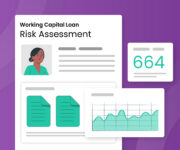The Micro, Small, and Medium Enterprise (MSME) sector continues to be a promising yet underserved segment in the credit market. By March 2024, for instance, the MSME loan segment witnessed a 17.8 % growth compared to the same period the previous year. The total valuation of the loan portfolio increased to INR 64.1 trillion.
Therefore, ambitious lenders looking to capitalise must focus on serving MSMEs more effectively. However, lenders struggle with a lack of preparedness and the right tools to navigate the sector.
In this article, we deep-dive into key challenges and address how lenders can leverage strategy and technology to grow the MSME loan segment.
Key Challenges in Scaling MSME Loans
The needs of MSMEs are diverse as compared to large corporations. Here are key challenges many lenders grapple with:
Borrowers with No Credit History
Many MSMEs are first-time borrowers. Hence, they do not have a credit history. With no credit history, many lenders tend to reject them outright.
Borrowers with No Assets
Without a credit history, lenders may demand assets to be used as collateral against an MSME loan. However, MSMEs may not have any assets.
This puts them at a disadvantage in the organised credit market, and they may turn to predatory moneylenders instead. This scenario comes with an opportunity cost for lenders.
Wide Spectrum of Needs
Borrower needs span a broad spectrum. In the fourth quarter of FY 2023, the average loan size was 9,0 lakhs for medium-sized businesses, 44.2 lakhs for small-sized businesses, and 8.1 lakhs for micro businesses.
Micro enterprises may need to borrow as little as INR 50,000. Hence, a one-size-fits-all approach cannot work. However, lenders may lack the tools to customise MSME loans.
What is AI-Driven Risk Assessment?
AI-driven risk assessment is a strategic solution where lenders leverage technology to deliver accurate, data-driven underwriting outcomes.
A superior loan origination solution uses multiple technologies in conjunction to automate all processes. Key technologies include:
- Artificial Intelligence (AI)
- Machine Learning (ML)
- Robotic automation
- Cloud computing
- Optical character recognition
In turn, the loan origination process is more efficient and optimised to ensure a higher loan repayment rate and reduce risk.
In particular, lenders can harness this innovative solution to serve MSMEs more effectively. Not only can they assess the creditworthiness of smaller-sized businesses with no credit history and assets, but they can also do so more accurately.
This solution also comes with additional benefits, such as MSME loan customisation and the use of alternative financial data.
AI-Driven Risk Assessment Strategies for MSME Loans
Here’s a look at AI-driven risk assessment strategies that are helping lenders drive higher impact in the MSME loan segment and scale faster:
In-depth Cash Flow Analysis
First-time borrowers may not possess a credit history. They may not have real estate, shares, and bonds, which can be used as collateral. However, these are not necessarily indicators that they will be unable to repay a loan.
Lenders must conduct an in-depth cash flow analysis to get a realistic financial picture of an MSME’s business revenues, expenses, and profits.
A positive cash flow spanning a significant time frame can indicate a business has consistent revenues. Businesses with positive cash flows are more likely to repay a loan on time and in full.
By adopting AI-powered cloud-based lending software, lenders can automate the analysis process. This approach ensures efficiency, accuracy, and quick turnarounds in the MSME loan analysis process.
Cross-reference Revenues with GSTN Data
Lenders may be concerned about the authenticity of revenue data. For instance, businesses may resort to tactics such as circular transactions to give the appearance of revenues. This is where Goods & Services Tax Network (GSTN) cross-analysis can help them authenticate such data.
A GSTN analysis entails cross-referencing every sales transaction with the corresponding GSTN data.
A superior AI-powered loan analysis solution comes with such a capability and enables automation of the entire process. Furthermore, lenders can directly pull the data from the GSTR portal with the borrower’s consent.
Higher Underwriting Accuracy
Using AI in loan origination solutions is a transformative development for MSME loan providers. Lenders can shift to a data-driven culture and reduce biases that put MSMEs at a disadvantage. They come with the following advantages:
- Data governance processes can be optimised. For instance, all data can be processed to ensure it is organised, segregated, and analysed accurately.
- The data can be automatically extracted from over 1000 document formats. This capability eliminates the need for human intervention.
- Data is categorised into over 30 inflow and outflow categories. This segregation enables lenders to generate detailed reports based on their specific needs.
- An AI-driven risk assessment software generates an alternative credit score. This capability helps lenders benchmark MSME borrowers accurately.
- These processes reduce errors in data management. They also boost the accuracy of underwriting outcomes.
Superior Fraud Detection Capabilities
AI can recognise unusual transaction patterns that are invisible to the human eye. Such patterns can be detected quickly, without human intervention, and flagged to lenders for further investigation. Here are some examples:
- An irregular pattern can warn lenders of potential loan fraud.
- AI can recognise minute differences in data, which can indicate cases of identity theft.
- AI can also isolate poor consumer behavioural patterns such as too many overdrafts, tax liabilities, and bounced cheques.
Such data is highly valuable in helping lenders make data-driven decisions. In turn, lenders can reduce Non-Performing Assets (NPAs), loan delinquencies, loan fraud, and identity impersonation.
Automated Customisation of Products
As of March 2024, there were 40 million MSMEs registered on the Udyam registration portal. Of these, micro-enterprises account for over 97%. The key to serving this market better is to make loan terms and conditions relevant to each enterprise.
Hence, customised loans are the way forward. The use of AI-powered lending software enables lenders to automate the customisation process. This approach not only expedites loan approvals. Lenders can also offer affordable loans that are more likely to repay the loans, thus reducing risks.
Key Takeaway
As credit demand among MSMEs grows, lenders must be prepared to capitalise on the opportunity with the right tools and strategies.
By boosting AI-driven risk assessment capabilities, lenders can serve borrowers of diverse business profiles more effectively. They can simultaneously address key MSME loan challenges such as lack of data, assets, and diverse loan needs and drive sustainable business growth.
Finezza offers comprehensive tools and solutions to manage your lending portfolio. Our end-to-end loan management solutions are trusted by brands like ftcash, Hiranandani Financial Services, gromor Finance, and UC Inclusive Credit, to name a few.
Also, Finezza’s intuitive bank statement analysis software is geared to analyse bank statements quickly and accurately and detect potential fraud.
Book a demo to know more.




Leave a Reply